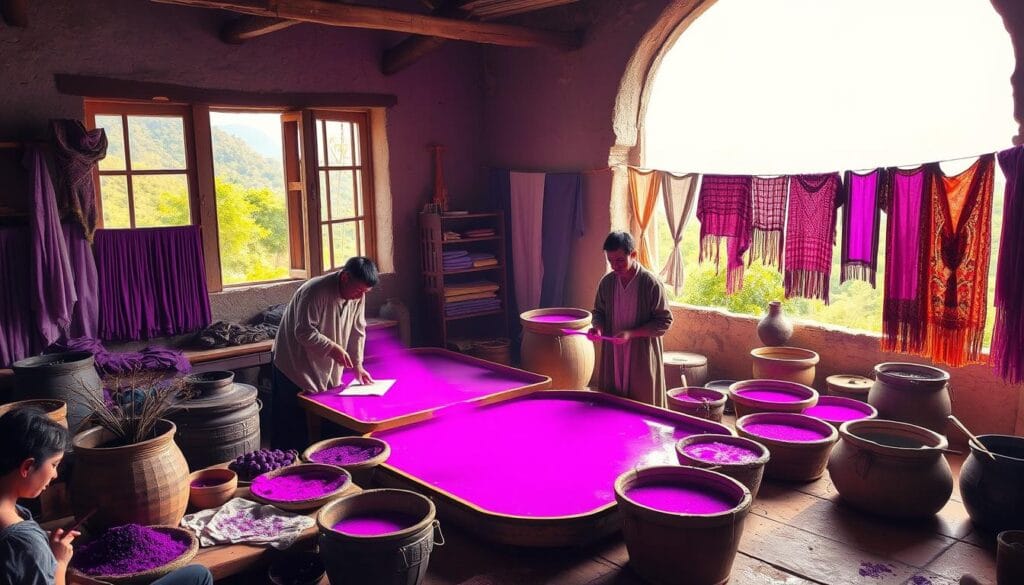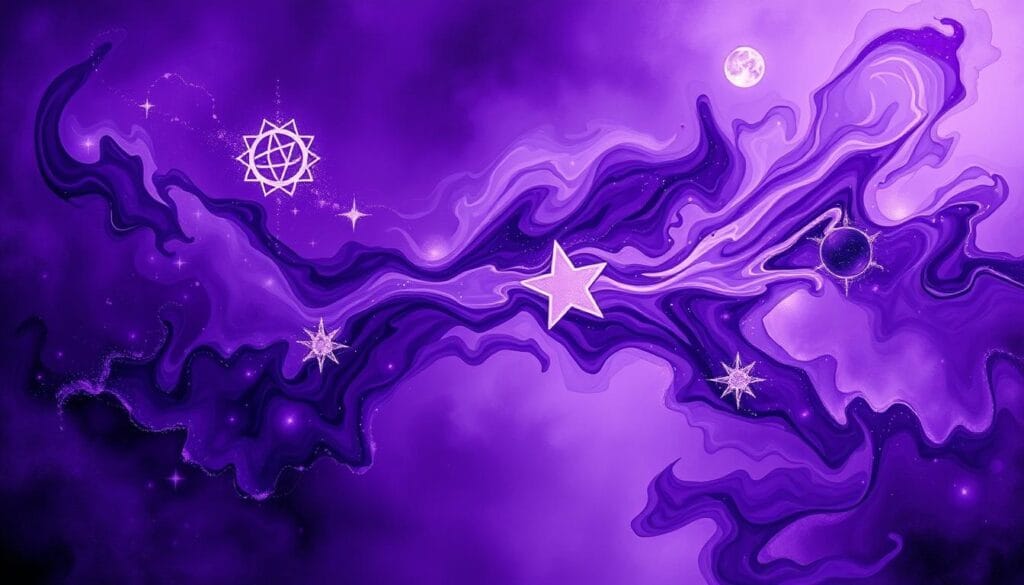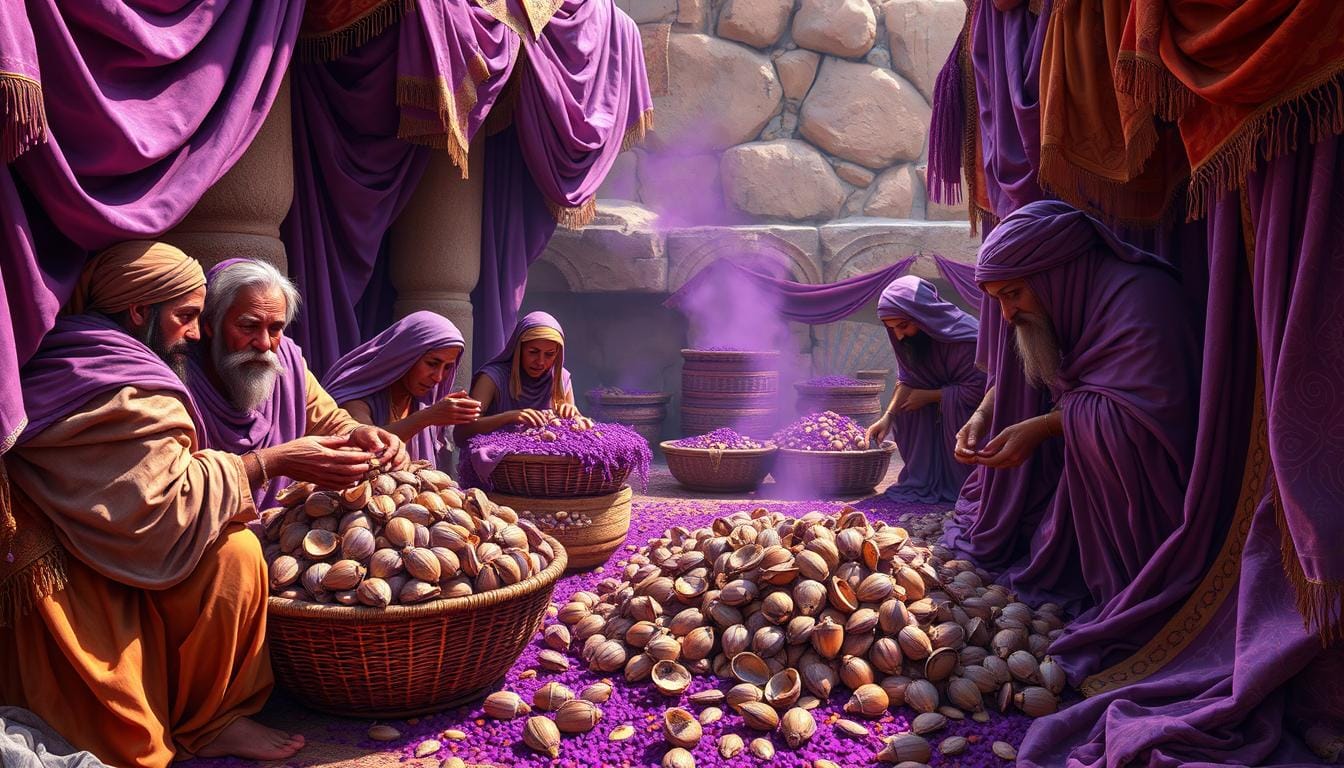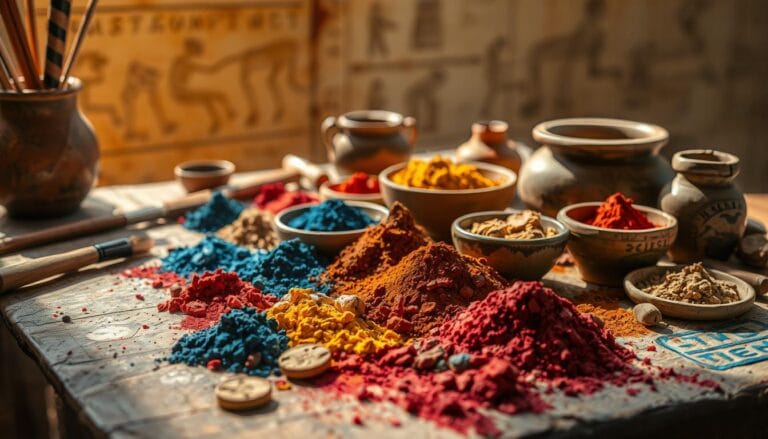The Alchemy of Purple: Why It Was Once Worth More Than Gold
Imagine walking through an ancient market, surrounded by vibrant colors. Among them, purple stands out. It was a color for the elite, known only to emperors and kings. Purple was so rare and beautiful that it was seen as more valuable than gold.
As you explore the history of purple dye, you’ll see its value goes beyond looks. It’s a mix of alchemy, rarity, and power that has captivated us for ages. The story of purple is filled with ambition, luxury, and the quest for beauty. Let’s dive into the enchanting world of purple, a color that has stood the test of time.
The Historical Significance of Purple Dye
Purple dye has a big role in history, especially because of its ancient origins. The Phoenicians were the first to get this color from the murex sea snail. It took thousands of snails to make just a little dye.
This hard process made purple dye very special. It was seen as a luxury for the rich. This made it a royal color.
The rarity of purple dye made it very valuable in ancient markets. As trade grew, like on the Silk Road, more people wanted this color. This led to new ways of dyeing and mixing colors.
Laws made sure only the rich could wear purple. Poets and historians, like Homer in the Odyssey, often talked about it. This showed how important purple was in ancient times.
The connection between purple dye and trade was strong. It helped local economies and made purple a symbol of wealth. It was even more valuable than gold.
| Aspect | Detail |
|---|---|
| Origin | Extracted from murex sea snails |
| Process | Required thousands of snails for small yields |
| Trade Routes | Prominent in the Silk Road exchanges |
| Symbolism | Associated with royalty and elitism |
| Historical Reference | Mentioned in Homer’s Odyssey |
| Comparison Value | Valued more than gold in antiquity |
The Alchemy of Purple
The chemistry of purple dyes is a mix of science and art, based on old traditions. It shows how important ancient dye-making methods were. The process of making purple colors involves complex chemical reactions. These reactions come from natural sources and need careful steps.
Extracting pigments from certain plants and shellfish shows the skill passed down through the ages. This skill is a testament to the craftsmanship that has grown over centuries.
Understanding the Chemistry Behind Purple Dyes
The heart of purple dye chemistry is the reaction of certain compounds. For example, indigo and anthocyanins are key to purple pigments. These chemicals mix with fibers through various extraction methods.
This creates dyes that not only color fabrics but also hold historical value.
An Exploration of Ancient Techniques
Ancient dye-making used natural resources, showing the skill involved. The Phoenicians were famous for dyeing from murex shellfish. Their process was labor-intensive, showing the value and rarity of purple fabric.
These methods show the artistry and secrecy of communities that valued purple dyes. They used these dyes for status and self-expression.
Purple Color Symbolism Through the Ages
Purple is more than a color; it’s a symbol of history and culture. It stands for royalty, spirituality, and high social status. This is thanks to its rarity and rich past.
The Royal Connection to Purple
Purple has always been a sign of power and status. The hard work to get purple dye from sea snails made it very expensive. In the Byzantine Empire, only the emperor could wear purple silk, showing its value.
In Renaissance Europe, purple showed who was noble. People in purple were seen as high up in society. Today, purple is still used to show luxury and power in branding and politics.
Cultural Associations with Purple in Different Civilizations
Purple has different meanings in different cultures. In religion, it’s linked to spirituality and the crown chakra. It helps with self-discovery and mental balance.
In popular culture, purple means something big and flashy. It’s used in fashion and branding to show luxury. Artists and designers use purple to add a touch of elegance to their work. Here’s a table showing how purple is seen in different areas:
| Context | Purple Significance |
|---|---|
| Royalty | Symbol of power and exclusivity, historically reserved for nobility. |
| Religion | Associated with spirituality and enlightenment; ties to the crown chakra. |
| Art and Fashion | Evokes feelings of luxury and high status; often used in branding. |
| Psychology | Promotes introspection and mental balance; linked to emotional well-being. |
The Economic Value of Purple in Ancient Times
Purple dye was a symbol of luxury and wealth in ancient times. It was not just a color but a key player in ancient economies. By comparing its price to gold, we can see how important it was in trade and politics.
Comparing Costs: Purple Dye vs. Gold
Purple dye was incredibly expensive, sometimes costing four times as much as gold. It took about 10,000 murex snails to make just 1.5 grams of dye. This made it very rare and valuable.
In the Roman Empire, a pound of purple dye could cost 15,000 denarii. This was more than a Roman soldier’s yearly salary. Purple clothes were 12 to 15 times more expensive than regular clothes.
In Rome, only emperors and high officials could wear purple. This was to show their status. Breaking this rule could mean death, showing how important purple was.
The Role of Trade in the Distribution of Purple Dye
Trade routes for purple dye were crucial for ancient commerce. They helped create specialized economies, especially in Phoenicia. This dye was so valuable that it changed how trade worked.
Artisans who could make purple dye were very important. They earned more than skilled workers in other fields. In the Byzantine Empire, purple-dyed textiles were gifts for emperors, showing their power and wealth.
Purple Alchemy in Nature
The world is full of natural purple dyes from plants and some animals. These plants add vibrant colors to textiles and enrich our ecological diversity. Learning about these sources shows their value in art and nature.
Natural Sources of Purple Pigments
Many plants create stunning purple pigments for dyeing. Some key ones are:
- Madder root – Known for its deep red to purple hues, this plant has been treasured for centuries.
- Logwood – Extracted from the heartwood, its rich purple dye remains popular in the textile industry.
- Indigo – While primarily associated with blue, specific processes can yield purple shades.
- Blackberries – Their juice can produce a vibrant range of purples.
Ecological Importance of Plants with Purple Dyes
Plants that provide purple dyes are vital for more than just color. They help keep biodiversity and ecological balance.
Benefits include:
- Enhancing local habitats that support various species.
- Contributing to sustainable agricultural practices through crop rotation.
- Supporting traditional farming methods that prioritize ecological diversity.
Protecting these plants keeps their colors and vital ecosystems safe. Their history shows how culture and nature are connected.
Appreciating plant-based dyes can make our world more sustainable. It helps us connect with nature more deeply.
Purple Alchemy in History
The history of purple dye is filled with cultural significance, innovation, and beauty. This section will explore the contributions of key figures in dye production. You’ll see how their work shaped ancient fashion and visual arts.
Famous Figures and Innovations in Dye Production
Many historical figures have made a big impact on dye production. The Phoenicians were among the first to create purple dye from murex snails. This color symbolized wealth and status.
The Romans also made big strides in dye technology. They found ways to make purple dye more available. This was thanks to better extraction methods and trade routes. Pliny the Elder documented these advancements, helping to pass on this knowledge.
Historic Uses of Purple in Clothing and Decoration
Purple dye has always held great importance in history. It was used by royalty and important figures in ancient times. Purple robes were a sign of power and divine right to rule.
Purple was also used in church vestments, showing piety and authority. Even in decorative arts, purple was key. It adorned tapestries and wall hangings, showing the wealth of their owners.

Purple Alchemy in Mysticism
Purple is deeply meaningful in mysticism, symbolizing spirituality and deeper truths. It’s valued worldwide, showing up in rituals and religious practices. The spiritual meaning of purple is complex, showing its importance in understanding human experiences and beliefs.
Spiritual Meaning of Purple Across Cultures
Purple’s spiritual meaning is seen in many cultures, often tied to enlightenment and higher consciousness. It connects the earthly and divine realms. For instance, in Christianity, purple is about penitence and spiritual preparation during Lent.
In Eastern traditions, purple links to the crown chakra, representing spirituality and intuition. Each culture sees purple in its own way, making it a common theme in rituals, art, and sacred places.
Alchemy as a Bridge Between the Material and Spiritual Worlds
Alchemy and spirituality meet in alchemy, a transformative process. It shows how physical elements mirror spiritual truths. The idea of “solve et coagula” (breaking down and rebuilding) reflects personal growth.
Alchemy is like a bridge between dye-making and seeking enlightenment. It shows how changing materials is like growing in consciousness. Exploring alchemy deepens our understanding of purple’s role in mysticism and its cultural significance.
Purple Alchemy in Literature
Purple in literature is a powerful symbol, full of meaning. Authors have used it to show character depth, social status, and complexity. Classic texts show how purple sets the tone and shapes stories, leaving a lasting impact on readers.
Its connection to royalty and spirituality adds depth to historical works. This makes the emotional landscape richer.
Symbolic Uses of Purple in Classic Texts
Many famous authors have used purple to create vivid images and themes. In “Hamlet” by Shakespeare, purple symbolizes power and sadness, adding to the tragedy. In Virginia Woolf’s novels, purple hints at the inner lives of characters, adding to their psychological complexity.
This highlights the deep connection between color and story. It invites readers to explore the stories’ subtleties.
Contemporary References to Alchemy and Purple
Today’s stories still explore alchemy through purple symbolism. Purple is seen as a symbol of transformation and identity in modern literature. Authors use purple to link characters’ journeys with themes of change and discovery.
This shows purple’s ongoing importance in storytelling. It represents both personal and societal changes, making it relevant today.
| Literature Era | Authors | Key Works | Themes Associated with Purple |
|---|---|---|---|
| Classic | Shakespeare | Hamlet | Power, Tragedy |
| Classic | Virginia Woolf | Mrs. Dalloway | Psychological Depth, Inner Conflict |
| Contemporary | Chimamanda Ngozi Adichie | Americanah | Identity, Transformation |
| Contemporary | Juan Gabriel Vásquez | The Sound of Things Falling | Change, Discovery |
Purple Alchemy and Transformation
Purple is more than just a color; it’s a symbol of change and growth. It carries deep meanings from different cultures. These meanings talk about change, growth, and new discoveries.
This color is linked to alchemy, where things change from one form to another. It’s like a journey of personal growth and spiritual awakening.
Metaphorical Meanings of Transformation Associated with Purple
Purple touches our emotions deeply. It’s used in spiritual practices like the Violet Flame meditation. This meditation uses purple to help people change their energy.
It helps clear old, stuck energy from our past. This energy comes from our family and past experiences. The goal is to raise our energy and connect with higher values like mercy and truth.
The Process of Transmutation in Alchemical Thought
In alchemy, purple is about moving from a lower state to a higher one. It’s about becoming pure and reaching our full potential. The journey from violet to white in meditation shows our quest for enlightenment.
Practicing meditation and deep breathing helps us connect with our spiritual side. It’s a way to understand ourselves on a deeper level.

| Practice | Description |
|---|---|
| Violet Flame Meditation | A meditation designed to surround the individual with a violet flame, aimed at transforming unresolved traumas. |
| Energetic Clearing | The practice helps vaporize samskaras, facilitating emotional and spiritual healing. |
| Breathing Technique | Involves a rhythmic inhalation and exhalation pattern to synchronize energy flow. |
| Figure-8 Visualization | A creative visualization technique enhancing connection and energy flow in relationships. |
Purple’s connection to transformation is deep and meaningful. It reminds us of the constant change in our lives. Embracing purple’s alchemical meaning can lead to big changes in how we see ourselves and grow.
Modern Perspectives on Purple Alchemy
The world of dye making has changed a lot with new dye technology. Now, we have synthetic dyes and better ways to get colors. These changes make making purple dye easier and faster. But, they also have big effects on the environment.
Using synthetic dyes is different from old ways that used natural things. You can see how these changes affect our planet.
The Evolution of Purple Dye Technology
For a long time, purple dye was very expensive. This was because making it was hard work. But now, we can make purple colors easily and quickly.
New methods like using microbes and digital printing are helping. These ways are better for the planet than old dyeing methods.
Current Trends in Art and Fashion Incorporating Purple
Purple is still a big deal in fashion and art today. Designers use purple to show creativity and mystery. They add it to their clothes.
In art, purple is used to show deep feelings and cultural meaning. Its popularity shows it’s a color that always looks good. It appeals to many people.
| Aspect | Traditional Methods | Modern Dye Technology |
|---|---|---|
| Production | Labor-intensive; often requires natural sources | Efficient; utilizes synthetic alternatives |
| Environmental Impact | Higher ecological footprint due to resource demands | Lower footprint through innovative techniques |
| Cultural Significance | Associated with royals and elite status | Versatile in modern art and fashion spheres |
| Color Variability | Limited by natural materials | Extensive range of shades achievable |
The Revival of Interest in Natural Dyes
A shift towards natural dyes is happening now. People are becoming more aware of environmental issues. This is leading to a rise in the use of plant-based purple dyes.
This change is because of a growing dislike for synthetic dyes. These dyes often come from harmful fossil fuels.
The Sustainability Movement and Purple Dyes
There’s a big push for sustainable dye production now. People want eco-friendly options. Natural dyes are seen as better for the environment and our health.
Artisans are going back to old ways of dyeing. They use things like madder root and indigo leaves. This creates beautiful purple colors and helps the planet.
Artisan Practices in Modern Dye Production
Artisan dyeing brings back old skills in dye making. It combines traditional methods with new ideas. These experts use natural materials to create amazing colors.
Their hard work shows how much they value the art of natural dyeing. It’s a way to appreciate the beauty of textiles made with natural sources.
Conclusion
The journey through purple dye’s significance shows its deep impact across many areas. It goes from ancient times to today’s art and spirituality. Purple was more than just a color; it meant power, wealth, and a link to the divine.
In the past, purple dye was very valuable, even more than gold. Its making was a complex process that showed the ancient world’s alchemy. Now, we’re seeing a comeback to natural dyes and sustainable practices. This mix of old and new is fascinating.
Reflecting on purple, we see it’s more than just a color. It has shaped trade, art, and how we express ourselves. Purple dye’s story is a rich tapestry of culture, history, and creativity. It reminds us of the power of color to connect and inspire.
FAQ
What is the historical significance of purple dye?
Purple dye was once more valuable than gold. It was rare and hard to make. Only the elite and royalty could afford it, showing their power and status.
How was purple dye produced in ancient times?
The Phoenicians extracted purple dye from murex shellfish. This ancient method was secret and labor-intensive. It made the dye very valuable.
Why is purple associated with royalty?
Purple was linked to royalty since ancient times. Roman emperors wore it to show their power. Its rarity and cost made it a symbol of nobility.
What are some cultural associations with purple?
Purple has meant many things over time. It’s linked to spirituality, creativity, and wisdom. In Christianity, it’s sacred. In other cultures, it means art and nobility.
How did the economic value of purple dye compare to gold?
Purple dye was incredibly valuable in ancient times. It was more valuable than gold because of the hard work and limited resources needed to make it. It was a highly sought-after trade item.
What are the natural sources of purple pigments?
Purple pigments come from plants and animals. Plants like indigo and certain berries give off purple colors. They’re important in the dye world.
Who were some important figures in the history of purple dye production?
Key figures in purple dye history were skilled craftspeople and merchants. They developed new methods, set up dye houses, and traded purple dye. They changed culture and economies.
How is purple represented in literature?
In books, purple shows character depth, status, and complexity. Authors use it to add richness to stories. It’s linked to nobility and change.
What is the significance of purple in modern art and fashion?
Purple is still important in art and fashion today. It shows the color’s lasting appeal. Designers and artists love its versatility.
How does the sustainability movement relate to purple dye?
The green movement has made people interested in natural dyes like purple again. As we care more about the environment, we’re looking at plant-based dyes. This helps protect nature.




